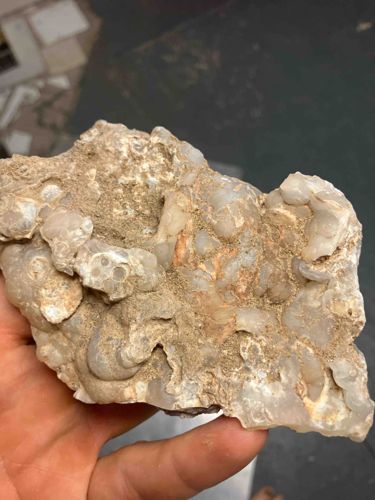
Botryoidal Chalcedony or Geode Fragment
The item is a natural geological specimen, likely a rock or mineral formation, held in a human hand, suggesting a size that is manageable and portable, possibly ranging from 6 to 10 inches in its longest dimension. Its primary coloration is a light, earthy brown to off-white, with significant areas exhibiting a crystalline or translucent appearance, indicative of quartz or a similar siliceous mineral. The texture is highly irregular and nodular, characterized by numerous rounded, bumpy protrusions resembling botryoidal or mammillary formations. Some areas show a rough, sandy, or soil-like accretion, suggesting it was recently excavated or is unprocessed. There are hints of a reddish-brown or orange hue within some of the lighter translucent areas, possibly due to iron staining or inclusions. Visible condition issues include natural erosion and deposition of sediment. There are no discernible manufacturing details, maker's marks, or signatures, as it appears to be a naturally occurring specimen. Its style period is geological, and its age would be ancient, corresponding to the natural formation processes. The unique aspect lies in its complex, organic-looking growth patterns, which suggest a slow mineralization process in a geode or vug. The craftsmanship is entirely natural, showcasing geological processes rather than human artistry. The presence of numerous small, circular indentations or openings in some of the botryoidal structures adds to its textural complexity and could indicate fossilized remains or natural dissolution patterns.
AI-Generated Appraisal Disclaimer
Estimated Value
$75 - $125
Basic Information
Category
Geological Specimen
Appraised On
November 30, 2025
Estimated Value
$75 - $125
Item Description
The item is a natural geological specimen, likely a rock or mineral formation, held in a human hand, suggesting a size that is manageable and portable, possibly ranging from 6 to 10 inches in its longest dimension. Its primary coloration is a light, earthy brown to off-white, with significant areas exhibiting a crystalline or translucent appearance, indicative of quartz or a similar siliceous mineral. The texture is highly irregular and nodular, characterized by numerous rounded, bumpy protrusions resembling botryoidal or mammillary formations. Some areas show a rough, sandy, or soil-like accretion, suggesting it was recently excavated or is unprocessed. There are hints of a reddish-brown or orange hue within some of the lighter translucent areas, possibly due to iron staining or inclusions. Visible condition issues include natural erosion and deposition of sediment. There are no discernible manufacturing details, maker's marks, or signatures, as it appears to be a naturally occurring specimen. Its style period is geological, and its age would be ancient, corresponding to the natural formation processes. The unique aspect lies in its complex, organic-looking growth patterns, which suggest a slow mineralization process in a geode or vug. The craftsmanship is entirely natural, showcasing geological processes rather than human artistry. The presence of numerous small, circular indentations or openings in some of the botryoidal structures adds to its textural complexity and could indicate fossilized remains or natural dissolution patterns.
Related Tags
Get Your Items Appraised
Instant estimates of your treasures with AI-powered instant appraisals